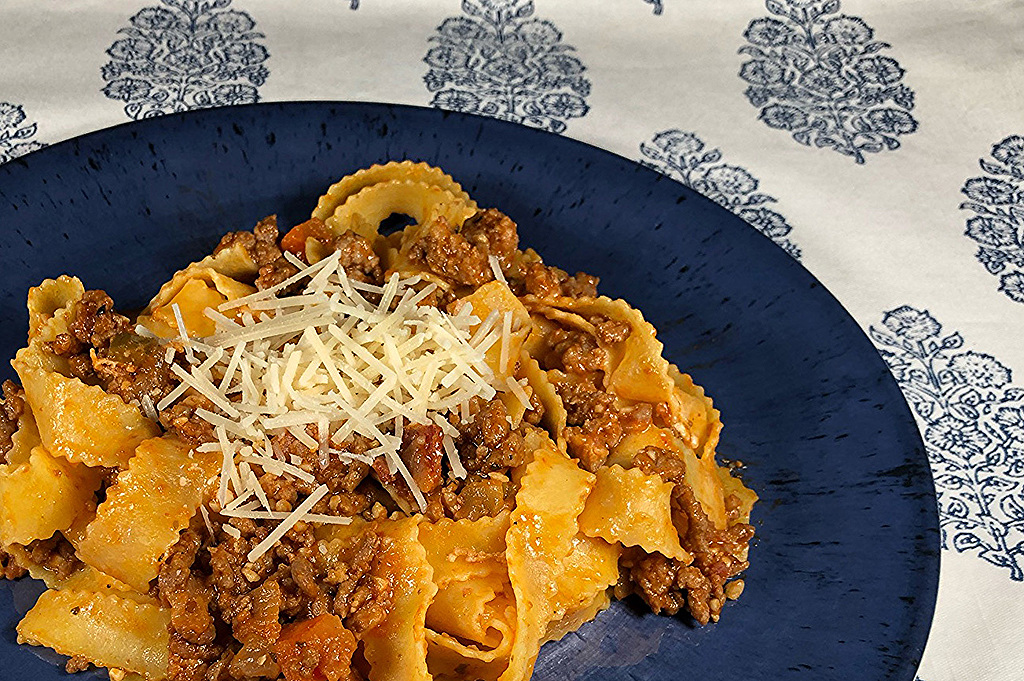Bolognese

It doesn’t take a lot of ingredients to make a classic Bolognese recipe. What it does take, though, is patience for the sauce to achieve the ideal authentic texture.
Favorite Italian Easy active45 mins total time3 hrs 45 mins servings4 addedJuly 2020
- ½ pound ground beef chuck, patted dry
- ½ pound ground pork, patted dry
- 1 medium onion, chopped
- 1 celery stalk, chopped
- 1 small carrot, peeled, chopped
- 2 cloves garlic, finely minced
- 2 tablespoons extra-virgin olive oil
- 3 ounces thinly sliced pancetta, finely chopped
- ⅓ cup tomato paste
- 1 cup dry white wine
- 1 pinch finely grated nutmeg
- 1 bay leaf
- (optional) 1 teaspoon rubbed sage
- (optional) 1 tablespoon oregano
- (optional) ½ teaspoon red pepper flakes
- Kosher salt
- Freshly ground black pepper
- 2 cups chicken stock
- 1 cup milk
- 1 pound fresh tagliatelle or pappardelle, or dry rigatoni
- ½ cup finely grated Parmesan, plus more for serving
- Combine the beef and pork in a large bowl. “Pull” the ground meat apart with two forks as if you were shredding pulled pork, breaking up the clumps and incorporating the meat without compacting it. Continue to pull the meat apart until thoroughly mixed and no clumps remain.
- Heat the oil in a Dutch oven or large heavy pot over medium-high heat. Cook the pancetta, stirring occasionally, until the fat has rendered and is golden brown on all sides, 4 to 6 minutes. Transfer the pancetta with a slotted spoon to a large bowl, leaving the fat in the pot.
- Spread the ground meat in an even layer in the pot and cook undisturbed until lightly golden brown, 1 to 2 minutes. Toss and continue to cook, breaking up any clumps with the back of a spoon and scraping up any browned bits from the pot, until the meat is lightly browned on both sides, 1 to 2 minutes more. Transfer the browned meat with a slotted spoon to the bowl with the pancetta, leaving the fat in the pot.
- While the meat is cooking, finely dice the onion, garlic, celery, and carrot to ⅛ inch or pulse in a food processor until very finely chopped.
- After removing the meat from the pan, reduce the heat to medium. Add the garlic, celery, carrots, onions, bay leaf, nutmeg, sage, oregano, red pepper flakes, 2 teaspoons salt and ¼ teaspoon pepper and cook, stirring occasionally, until the vegetables are tender but not browned, 8 to 10 minutes.
- Add the tomato paste and cook, stirring constantly, until very fragrant and brick red, about 2 minutes. Stir in the wine, bring to a boil and cook until it reduces and thickens and no smell of alcohol remains, 6 to 8 minutes.
- Stir in the stock, milk and browned meat.
- Bring to a boil, then reduce the heat to low. Simmer, stirring occasionally, until most of the liquid has evaporated away and the mixture resembles sloppy joes, 2½ to 3 hours. There shouldn’t be any rapid bubbles while cooking. Instead, the sauce should release occasional small bubbles. If you have a small burner you should use it; the larger burners even at their lowest setting might cook the sauce too quickly. If the sauce reduces too quickly, add ½ cup of stock or water and continue cooking; repeat if necessary. The sauce needs the full 2½ to 3 hours cook time to develop the flavors.
- Discard the bay leaf. Use the back of a spoon to break up any remaining clumps of meat for an even-textured sauce. Season with salt and pepper, and keep warm.
- Bring a large pot of salted water to a boil over high heat. Cook the pasta. If using fresh pasta, cook about 3 minutes. If using dry, cook until very al dente, about 2 minutes less than the package directions.
- Reserve 1 cup of the pasta cooking liquid, then drain the pasta and transfer to the sauce. Add ½ cup Parmesan cheese. Increase the heat to medium, bring the sauce to a simmer and cook, tossing the pasta constantly, until the pasta is al dente and the sauce is slightly thickened, adding pasta cooking liquid if necessary, about 2 minutes.
- Transfer the pasta to a platter and top with grated Parmesan.
Tips
- Sauce can be made 4 days ahead. Cover and chill.
- Traditional recipes don’t call for sage, oregano or red pepper flakes. It’s delicious with or without the extra spices.
- If necessary, you can substitute bacon for the pancetta.